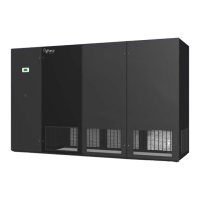28
5.3.2 Flooded System Charging
Flooded type systems are units having refrigerant circuits with an optional liquid receiver and head
pressure control valve. When the ambient temperature falls during cold weather, the head pressure
control valve will regulate the ow of refrigerant to ensure minimum receiver pressure. The condenser
is partially ooded with liquid refrigerant in cold weather to maintain a minimum liquid line pressure. In
warm weather the extra refrigerant is stored in the receiver.
Flooded systems require more refrigerant than fan speed control systems due to the receiver added
volume. To charge, connect the pressure gauge manifold set to the high and low ports near the
compressor. Connect the charging line to the refrigerant tank and set it for liquid feed. Open the
refrigerant tank valve and purge the line. Open the high side valve on the manifold only and weigh
in the refrigerant until the proper amount of refrigerant is added that is required by the receiver in the
system (see Receiver Charging Chart). Receiver storage capacities are based on the liquid occupying
no more than 90% of the internal volume when the temperature of the refrigerant is 90°F (32°C) per
ASHRAE Standard 15-94.
Refrigerant Receiver Charging Chart
Model Size
kW (ton)
Dual Circuit
lbs./circuit (kg/circuit)
R-410A
Dual Circuit
lbs./circuit (kg/circuit)
R-407C
GHRC
DARC
021 thru 074
(6 thru 21)
43 (19.5) 48 (21.8)
GHRC
DARC
084 thru 130
(24 thru 37)
76 (34.5) 84 (38.1)
GHRC
DARC
141 thru 215
(40 thru 61)
122 (55.3) 135 (61.2)
GHRC
DARC
264 thru 352
(75 thru 100)
189 (85.7) 209 (94.8)
At this point the system is only partially charged.
A quick and easy way to run the compressor and fans is to use the manual switches on the unit’s
microprocessor. Switching the blower and compressor manual switches to the ON position will disable
the automatic control of these components but leave the safety switches functional.
WARNING: Before starting a compressor, the crankcase heater should be energized
for a minimum of 12 hours to reduce the possibility of liquid slugging on start-up. Failure
to energize the crankcase heater could result in compressor damage. If the system is
charged from a vacuum, the pre-heating of the compressor is not necessary.
If the receiver (head) pressure is below the value shown below for the refrigerant used, block part of
the condenser coil surface until the pressure rises to the value shown or higher. During extremely cold
weather all the condenser fans may have to be de-energized to maintain head pressure. At this point
slowly add refrigerant to the system until the ball in the sight-glass on the receiver is at the 1/3 level
mark.
The system should be allowed to stabilize for 15 to 20 minutes before meaningful measurements can
be taken. The superheat at the compressor suction line (reading from at least 6 inches (152 mm) from
the sight glass) should be 8 to 15°F
(-13.3 to -9.44°C). After the system is allowed to stabilize, verication
of a few key measurements should be noted:

